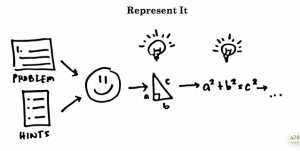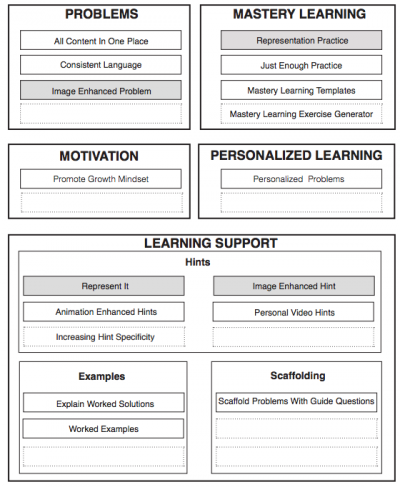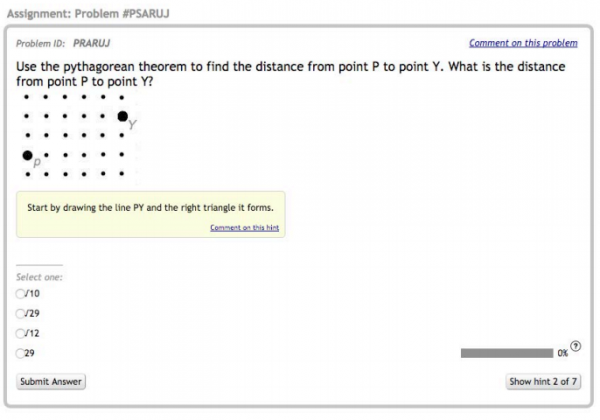Represent It
| Represent It | |
| Contributors | Paul Salvador Inventado, Peter Scupelli |
|---|---|
| Last modification | June 6, 2017 |
| Source | Inventado and Scupelli (2016).[1] |
| Pattern formats | OPR Alexandrian |
| Usability | |
| Learning domain | |
| Stakeholders | |
Encourage students to externalize their thoughts using representations to help them better understand the problem and figure out the answer.
Context
Students are answering a math problem on an online learning system to help them understand a topic they recently learned.
Problem
Students find it difficult to solve problems when they think about solutions abstractly.
Forces
- Increased difficulty. Solving problems mentally is difficult because working memory is limited. It becomes harder to process information as working memory becomes occupied by the different elements required to solve the problem.
- Careless mistakes. Students are susceptible to committing unintended errors when they try to solve problems mentally especially when they experience high cognitive load.
- Impaired metacognition. High cognitive load makes it difficult to manage the learning task. Students may have difficulty tracking their progress, evaluating their performance, or selecting effective learning strategies.
Solution
Therefore, encourage students to externalize their thoughts with representations that foster the understanding of the problem or leads to the correct answer. Online learning systems often provide facilities for automated feedback such as hints, error messages, or follow-up questions. These functionalities may be used to remind the student to write down notations, figures, tables, or other representations that may help visualize the problem and solution more concretely.
Provide just enough details about the representation for the student to use it. Too much information might make the problem too easy.
Consequences
Benefits
- Externalizing the elements of the problem frees up the working memory making it easier to process information.
- Compared to mental representations, it is easier to locate and address errors in externalized representations because they can be seen explicitly. Externalizing representations also frees up working memory, which facilitates focused processing.
- Students are better able to perform metacognitive tasks with less cognitive load. Metacognition helps students evaluate, assess, and revise their learning strategies.
Liabilities
- The online learning system needs to support feedback mechanisms to use the pattern (e.g., hint messages).
- The student should have some prior knowledge on using the representation otherwise they would not be able to use it.
- In some cases, there may be multiple representations that lead towards the problem’s solution. The optimal order and necessary types of representations that are created and used may vary by student.
Evidence
Literature
- Writing down representations, just like drawing figures or notations, makes it easy to view problem details without keeping them all in memory[2]. Using a more tangible medium may decrease cognitive load and make it easier to make inferences.
- It is difficult to complete a task when too much information is introduced because of working memory limitations[3].
- Expert guidance, such as providing hints, may help students achieve difficult tasks within the Zone of Proximal Development, which they are unable to do on their own[4][5].
- Desirable difficulty is beneficial to learning because activities that are too easy or do not challenge learners’ understanding of a concept require less mental processing and often, less learning[6][7]
Related patterns
The Represent It design pattern can be used while implementing the Representation Practice design pattern to prompt students to represent problems and their solutions. Images may be used to clarify hints if students are still unable to solve the problem as described in the Image-Enhanced Hint design pattern. Students may be allowed to request for more hints when they need it, but only provide enough information each time to maximize their learning opportunity as described in the Increasing Hint Specificity design pattern. The figure below shows a map of the aforementioned patterns, which helps to explain how they are related.
Example
Math teachers often encourage students to think of a problem’s representation and write it down to help them solve problems (e.g., “Draw a figure”). Teachers reinforce this skill by reminding students to use representations and make inferences from them (e.g., McIntosh 2015[8], Noh et al. 2013[9], Polya 2014[2]). This is also seen in some online learning systems such as ASSISTments[10], which provides hints that remind students to draw figures. Picture Algebra[11] is another online learning system that encourages students to draw figures and asks questions regarding the figure they drew to help them solve a given problem.
The following figure shows an example of a hint in the ASSISTments online learning system. The hint reminds the student to draw a right triangle, which is the first step in the problem solving process. The hint provides enough information for students to recall the process and make inferences that may lead them to the solution.
References
- ↑ Inventado, P.S. and Scupelli, P. (2016). Design Patterns for Helping Students to Learn to Visualize Math Problems in Online Learning Systems. In Proceedings of the 21st European Conference on Pattern Languages of Programs (EuroPLoP 2016). New York:ACM.
- ↑ 2.0 2.1 Polya, G. (2014). How to solve it: A new aspect of mathematical method. Princeton university press.
- ↑ Sweller, J. (2004). Instructional design consequences of an analogy between evolution by natural selection and human cognitive architecture. Instructional science, 32(1-2), 9-31.
- ↑ Hume, G., Michael, J., Rovick, A., & Evens, M. (1996). Hinting as a tactic in one-on-one tutoring. The Journal of the Learning Sciences, 5(1), 23-47.
- ↑ Vygotsky, L. S. (1962). Language and thought. Massachusetts Institute of Technology Press, Ontario, Canada.
- ↑ Bjork, R.A. (1994). Memory and metamemory considerations in the training of human beings. In J. Metcalfe and A. Shimamura (Eds.). Metacognition: Knowing about knowing. Cambridge, MA: MIT Press, 185-205.
- ↑ Piaget, J. (1952). The origins of intelligence. New York: International University Press.
- ↑ McIntosh, K.L. (2015). Montessori Mathematics Curriculum and Lower Elementary Students Understanding of Length Measurement. Masters of Arts in Education Action Research Papers. Paper 148.
- ↑ Noh, J., Warren, J., Huh, N., & Ko, H. K. (2013). Instruction Using Scaffolding for Language Learner Students in Solving Mathematical Word Problems. Research in Mathematical Education, 17(3), 169-180.
- ↑ Heffernan, N.T. and Heffernan, C.L. (2014). The ASSISTments Ecosystem: Building a Platform that Brings Scientists and Teachers Together for Minimally Invasive Research on Human Learning and Teaching. International Journal of Artificial Intelligence in Education 24(4), 470-497.
- ↑ Koedinger, K. R. (2002). Toward Evidence for Instructional Design Principles: Examples from Cognitive Tutor Math 6. In Proceedings of the Annual Meeting [of the] North American Chapter of the International Group for the Psychology of Mathematics Education, ERIC/CSMEE Publications, Columbus, OH, USA, pp. 21-49.


